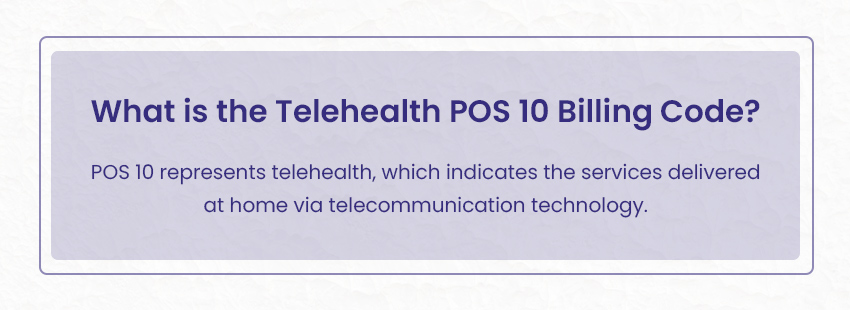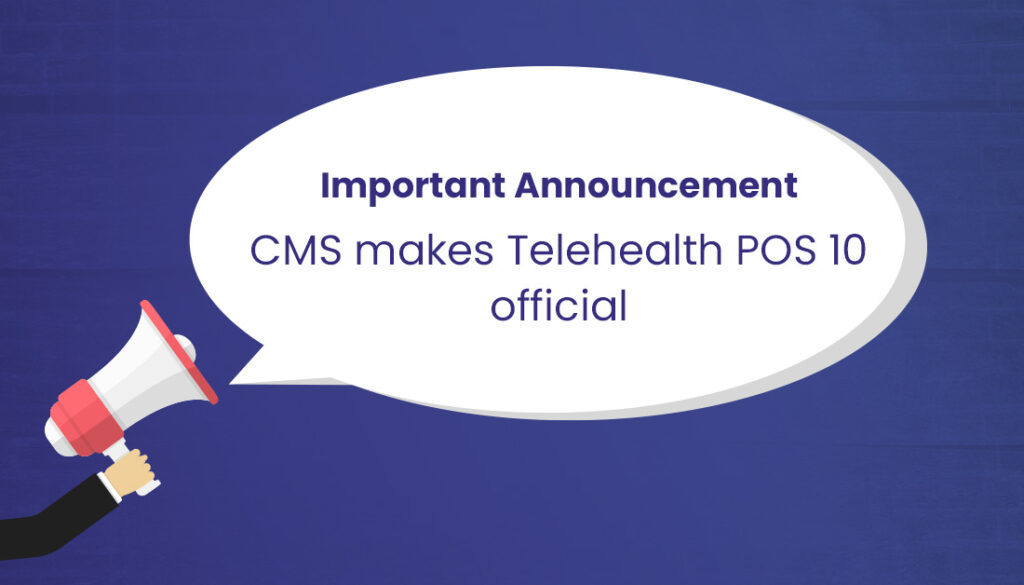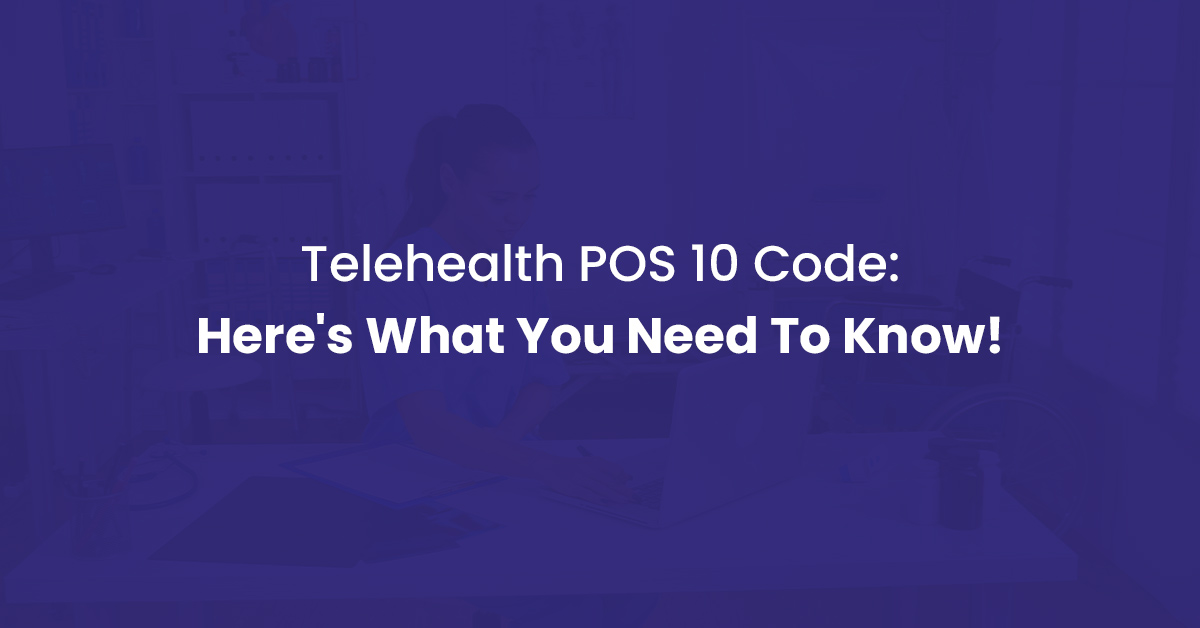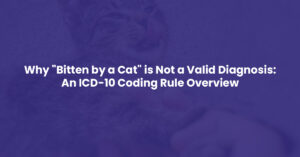When billing telehealth, understanding the POS code is essential to represent where the service was delivered. A POS code, in the context of telehealth, indicates the location where healthcare services are delivered using telecommunication technology.
Specifically, it applies to situations where the patient receives care at home- a private residence, not a hospital or facility, through a telehealth platform.
Important Tips for Telehealth Visits
➜ Real-Time with Audio & Visual: Telehealth visits must be conducted in real-time using both audio and visual communication channels.
➜ Proper Documentation: Thorough documentation is crucial for telehealth visits. Here’s a checklist:
- Mode: Indicate the mode used for the visit (e.g., video conferencing).
- Date & Duration: Document the date and duration of the telehealth visit.
➜ Complete Documentation: Maintain the same level of detailed notes as you would for an in-person visit.
Telehealth POS 10 Billing Code

The POS 10 billing code is the POS 10 code used in billing and coding to indicate the location (home, a location other than hospital or facility) where the healthcare service was delivered.
Let’s be more specific:
POS 10 represents telehealth, which indicates the services delivered at home via telecommunication technology. It includes; telemedicine visits, teletherapy sessions, remote patient monitoring or any telehealth care provided at a place – home, where the patient and the provider are not present physically in the same location.
| Place of Service Code | Place of Service Name | Place of Service Description |
| 10 | Telehealth Provided in Patient’s Home | Telehealth provided in patient’s homes. Patient is located in their home (which is a location other than a hospital or other facility where the patient receives care in a private residence) when receiving health services or health related services through telecommunication technology. |
Place of Service (POS) 10 for Home Visits — Effective January 1, 2024
The place of service code represents the location where the telehealth services are performed and are denoted by specific codes. POS 10 (service delivered at home) is one of the most commonly used codes on the CMS-1500 form.
Here’s what the new policy for Telehealth POS 10 code states:
🔷 INTRODUCTION
The Medicare administrators have decided that starting January 1, 2024, doctors will be permitted to bill for house calls over the telephone.
In the past, the rules for getting paid were different depending on where the doctor and patient were during a call. If the doctor was in his office and the patient was at home, the rates were lower.
Now the Medicare administrators have issued instruction number 12671 explaining that when a doctor calls a patient at home, it will be considered the same as an in-person house call for billing purposes.
🔷 NEW RULE
The old guidelines, outlined in the Medicare Internet Manual 100-04, had specified different payment levels based on where the doctor and patient were located during a call.
The new ruling clarifies that for calls where the patient is at home, doctors can bill at the full rate for an in-person house call visit. Many doctors had requested this change, saying it made no sense to pay less for a call just because the patient was at home.
Starting in 2024, a house call is a house call, whether done over the phone or in person.
🔷 POLICY OUTLINE
➺ Effective Date: January 1, 2024
➺ Implementation Date: July 8, 2024
➺ Payment: Claims for these services using POS code 10, if payable by Medicare, will be reimbursed at the non-facility rate according to the Medicare Physician Fee Schedule.
➺ Originating Site Facilities: POS code 10 does not apply to originating site facilities billing a facility fee.
🔊 Important Announcement: “CMS makes Telehealth POS 10 official”

CMS makes telehealth POS 10 official and lists it under covered telehealth services. After giving it much thought the authorities have finally decided to make a permanent policy change in the POS 10 status and have given instructions to pay the claims for covered POS 10 telehealth services.
Now, “covered” are the telehealth services that are on the CMS’ list of telehealth services. The effective date for making it official was 1st Jan, 2024.
The purpose of making it official is to notify Medicare Administrative Contractors (MACs) that covered telehealth services that use POS 10 and are payable by Medicare, must be paid at the Medicare Physician Fee Schedule non-facility rate.
Note: Non-facility rate is the reimbursement amount set by Medicare for services provided in non-facility settings. And the non-facility setting is a location that is not a part of the hospital such as provider offices, clinics, etc.
What are the different Telehealth Places of Service?
| Place of Service Code | Place of Service Name | Place of Service Description |
| 01 | Pharmacy | A facility or location where drugs and other medically related items and services are sold, dispensed, or otherwise provided directly to patients. (Effective October 1, 2003) (Revised, effective October 1, 2005) |
| 02 | Telehealth provided other than in patient’s home | The location where health services and health related services are provided or received, through telecommunication technology. Patients are not located in their home when receiving health services or health related services through telecommunication technology. (Effective January 1, 2017) (Description change effective January 1, 2022, and applicable for Medicare April 1, 2022.) |
| 03 | School | A facility whose primary purpose is education. (Effective January 1, 2003) |
| 04 | Homeless shelter | A facility or location whose primary purpose is to provide temporary housing to homeless individuals (e.g., emergency shelters, individual or family shelters). (Effective January 1, 2003) |
| 05 | Indian health service free-standing facility | A facility or location, owned and operated by the Indian Health Service, which provides diagnostic, therapeutic (surgical and non-surgical), and rehabilitation services to American Indians and Alaska Natives who do not require hospitalization. (Effective January 1, 2003) |
| 06 | Indian health service provider-based facility | A facility or location, owned and operated by the Indian Health Service, which provides diagnostic, therapeutic (surgical and non-surgical), and rehabilitation services rendered by, or under the supervision of, physicians to American Indians and Alaska Natives admitted as inpatients or outpatients. (Effective January 1, 2003) |
| 07 | Tribal 638 Free-standing Facility | A facility or location owned and operated by a federally recognized American Indian or Alaska Native tribe or tribal organization under a 638 agreement, which provides diagnostic, therapeutic (surgical and non-surgical), and rehabilitation services to tribal members who do not require hospitalization. (Effective January 1, 2003) |
| 08 | Tribal 638 Provider-based Facility | A facility or location owned and operated by a federally recognized American Indian or Alaska Native tribe or tribal organization under a 638 agreement, which provides diagnostic, therapeutic (surgical and non-surgical), and rehabilitation services to tribal members admitted as inpatients or outpatients. (Effective January 1, 2003) |
| 09 | Prison/ Correctional Facility | A prison, jail, reformatory, work farm, detention center, or any other similar facility maintained by either Federal, State or local authorities for the purpose of confinement or rehabilitation of adult or juvenile criminal offenders. (Effective July 1, 2006) |
| 10 | Telehealth Provided in Patient’s Home | The location where health services and health related services are provided or received, through telecommunication technology. Patient is located in their home (which is a location other than a hospital or other facility where the patient receives care in a private residence) when receiving health services or health related services through telecommunication technology. (This code is effective January 1, 2022, and available to Medicare April 1, 2022). |
| 11 | Office | Location, other than a hospital, skilled nursing facility (SNF), military treatment facility, community health center, State or local public health clinic, or intermediate care facility (ICF), where the health professional routinely provides health examinations, diagnosis, and treatment of illness or injury on an ambulatory basis. |





